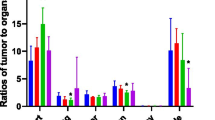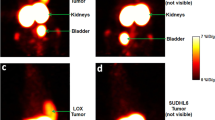Abstract
Purpose
This laboratory has previously published on phosphorodiamidate morpholino (MORF) pretargeting of tumor in which an anti-tumor antibody conjugated with MORF (a DNA analogue) is first administered, followed at a later time by the radiolabeled complementary MORF (cMORF) as the effector. In the present study, the pharmacokinetics of the antibody and effector were measured under different conditions in mice to establish their quantitative relationships with tumor accumulations by pretargeting.
Methods
A cytosine-free 18 mer cMORF was conjugated with MAG3 for 99mTc labeling while the anti-CEA antibody MN14 was conjugated with DTPA for 111In labeling and with MORF to impart binding affinity for radiolabeled cMORF. Mice bearing LS174T thigh tumors were used to study: (1) the pharmacokinetics of MN14-MORF by administering 111In-MN14 at doses between 10 and 100 μg with sacrifice at 2 days and at 30 μg with sacrifice between 1 and 3 days; (2) the biodistribution of 99mTc-cMORF following one to four injections (containing 0.15 μg each and separated by 1 h) to animals having received 30 μg of antibody–MORF 2 days earlier and with sacrifice at 3 h after the final injection; and (3) the influence on the biodistribution of 99mTc-cMORF of a 2 to 4 day interval between the administration of 30 μg of antibody–MORF and 0.30 μg of 99mTc-cMORF.
Results
(1) The biodistribution of antibody in percent accumulation (%ID or %ID/g) was largely independent of antibody dose but the absolute accumulation of antibody in tumor increased linearly with dose, showing no evidence of tumor saturation of CEA sites by MN14. Over 1–3 days post antibody administration, blood levels of radiolabeled antibody decreased as expected; however, tumor levels remained constant, thus showing an absence of antibody clearance in tumor over this period. (2) With fixed antibody–MORF dose and increasing number of injections of 99mTc-cMORF, cumulative percent blood levels steadily decreased in agreement with the values calculated based on the antibody–MORF in blood. In contrast, cumulative percent tumor levels stayed fairly constant over the first two injections. Thus the antibody–MORF in tumor became saturated with cMORF more slowly than that in blood owing to delivery differences. (3) As expected, percent blood levels decreased with increasing interval between injections of antibody–MORF and 99mTc-cMORF. The percent tumor accumulation, however, remained constant over the 3 day interval, thus demonstrating only slow loss of MORF expression in situ. The 99mTc-cMORF accumulation in tumor after saturation was mathematically determined based on the antibody–MORF concentration in tumor while the blood levels of 99mTc-cMORF were determined based on the concentration of antibody-MORF in blood.
Conclusion
Contrary to conclusions arrived at in our earlier study, the results of this study show that tumor CEA sites were not saturated even at the highest antibody dose investigated, that accessibility of MORF sites in tumor by 99mTc-cMORF was unhindered and that the maximum percent tumor accumulation of 99mTc-cMORF depended only on the tumor delivery efficiency of 99mTc-cMORF.






Similar content being viewed by others
References
Goldenberg DM. Advancing role of radiolabeled antibodies in the therapy of cancer. Cancer Immunol Immunother 2003;52:281–96
Boerman OC, van Schaijk FG, Oyen WJ, Corstens FH. Pretargeted radioimmunotherapy of cancer: progress step by step. J Nucl Med 2003;44:400–11
Goldenberg DM, Chang CH, Sharkey RM, Rossi EA, Karacay H, McBride W, et al. Radioimmunotherapy: is avidin-biotin pretargeting the preferred choice among pretargeting methods? Eur J Nucl Med Mol Imaging 2003;30:777–80
Paganelli G, Chinol M. Radioimmunotherapy: is avidin-biotin pretargeting the preferred choice among pretargeting methods? Eur J Nucl Med Mol Imaging 2003;30:773–6
Kraeber-Bodere F, Faivre-Chauvet A, Ferrer L, Vuillez JP, Brard PY, Rousseau C, et al. Pharmacokinetics and dosimetry studies for optimization of anti-carcinoembryonic antigenxanti-hapten bispecific antibody-mediated pretargeting of iodine-131-labeled hapten in a phase I radioimmunotherapy trial. Clin Cancer Res 2003;9:3973S–81S
Sharkey RM, Karacay H, Richel H, McBride WJ, Rossi EA, Chang K, et al. Optimizing bispecific antibody pretargeting for use in radioimmunotherapy. Clin Cancer Res 2003;9:3897S–913S
Rossi EA, Sharkey RM, McBride W, Karacay H, Zeng L, Hansen HJ, et al. Development of new multivalent-bispecific agents for pretargeting tumor localization and therapy. Clin Cancer Res 2003;9:3886S–96S
van Schaijk FG, Oosterwijk E, Soede AC, Oyen WJ, McBride WJ, Griffiths GL, et al. Pretargeting with labeled bivalent peptides allowing the use of four radionuclides: 111In, 131I, 99mTc, and 188Re. Clin Cancer Res 2003;9:3880S–5S
Sharkey RM, McBride WJ, Karacay H, Chang K, Griffiths GL, Hansen HJ, et al. A universal pretargeting system for cancer detection and therapy using bispecific antibody. Cancer Res 2003;63:354–63
Lindegren S, Karlsson B, Jacobsson L, Andersson H, Hultborn R, Skarnemark G. 211At-labeled and biotinylated effector molecules for pretargeted radioimmunotherapy using poly-L- and poly-D-lysine as multicarriers. Clin Cancer Res 2003;9:3873S–9S
Lewis MR, Wang M, Axworthy DB, Theodore LJ, Mallet RW, Fritzberg AR, et al. In vivo evaluation of pretargeted 64Cu for tumor imaging and therapy. J Nucl Med 2003;44:1284–92
Pavlinkova G, Batra SK, Colcher D, Booth BJ, Baranowska-Kortylewicz J. Constructs of biotin mimetic peptide with CC49 single-chain Fv designed for tumor pretargeting. Peptides 2003;24:353–62
Hytonen VP, Laitinen OH, Grapputo A, Kettunen A, Savolainen J, Kalkkinen N, et al. Characterization of poultry egg-white avidins and their potential as a tool in pretargeting cancer treatment. Biochem J 2003;372:219–25
Pagel JM, Hedin N, Subbiah K, Meyer D, Mallet R, Axworthy D, et al. Comparison of anti-CD20 and anti-CD45 antibodies for conventional and pretargeted radioimmunotherapy of B-cell lymphomas. Blood 2003;101:2340–8
Subbiah K, Hamlin DK, Pagel JM, Wilbur DS, Meyer DL, Axworthy DB, et al. Comparison of immunoscintigraphy, efficacy, and toxicity of conventional and pretargeted radioimmunotherapy in CD20-expressing human lymphoma xenografts. J Nucl Med 2003;44:437–45
Liu G, Mang’era K, Liu N, Gupta S, Rusckowski M, Hnatowich DJ. Tumor pretargeting in mice using 99mTc-labeled morpholino, a DNA analog. J Nucl Med 2002;43:384–91
Liu G, Liu C, Zhang S, He J, Liu N, Gupta S, et al. Investigations of 99mTc morpholino pretargeting in mice. Nucl Med Commun 2003;24:697–705
Liu G, He J, Dou S, Gupta S, Vanderheyden JL, Rusckowski M,et al. Pretargeting in tumored mice with radiolabeled morpholino oligomer showing low kidney uptake. Eur J Nucl Med Mol Imaging 2004;31:417–24
Liu G, Zhang S, He J, Liu N, Gupta S, Rusckowski M, et al. The influence of chain length and base sequence on the pharmacokinetic behavior of 99mTc-morpholinos in mice. Q J Nucl Med 2002;46:233–43
Liu G, He J, Zhang S, Liu C, Rusckowski M, Hnatowich DJ. Cytosine residues influence kidney accumulations of 99mTc-labeled morpholino oligomers. Antisense Nucleic Acid Drug Dev 2002;12:393–8
Winnard P Jr, Chang F, Rusckowski M, Mardirossian G, Hnatowich DJ. Preparation and use of NHS-MAG3 for technetium-99m labeling of DNA. Nucl Med Biol 1997;24:425–32
Hnatowich DJ, Layne WW, Childs RL, Lanteigne D, Davis MA, Griffin TW, et al. Radioactive labeling of antibody: a simple and efficient method. Science 1983;220:613–5
Liu G, Zhang S, He J, Zhu Z, Rusckowski M, Hnatowich DJ. Improving the labeling of S-acetyl NHS-MAG3 conjugated morpholino oligomers. Bioconjug Chem 2002;13:893–7
Goldenberg DM. Current status of cancer imaging with radiolabeled antibodies. J Cancer Res Clin Oncol 1987;113:203–8
Acknowledgements
The authors are grateful to Dr. Gary L. Griffiths of Immunomedics (Morris Plains, NJ) for providing the MN14. We also thank Loretta Lee of the UMMS Tissue Culture Center for maintaining the LS174T tumor cells. Financial support for this investigation was provided in part by the National Institutes of Health (CA79507, CA94994, and CA107360).
Author information
Authors and Affiliations
Corresponding author
Rights and permissions
About this article
Cite this article
Liu, G., He, J., Dou, S. et al. Further investigations of morpholino pretargeting in mice—establishing quantitative relations in tumor. Eur J Nucl Med Mol Imaging 32, 1115–1123 (2005). https://doi.org/10.1007/s00259-005-1853-5
Published:
Issue Date:
DOI: https://doi.org/10.1007/s00259-005-1853-5




